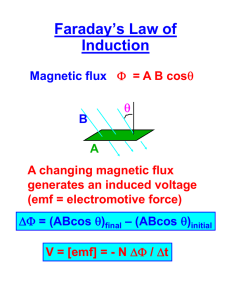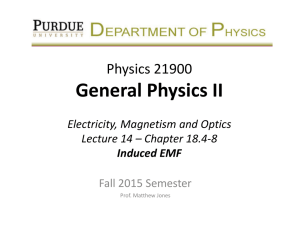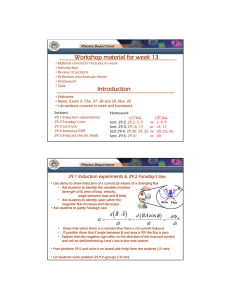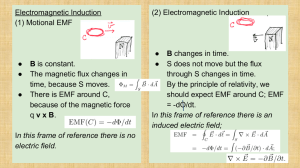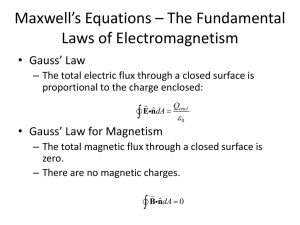Faraday`s law of induction states that the EMF induced by
advertisement
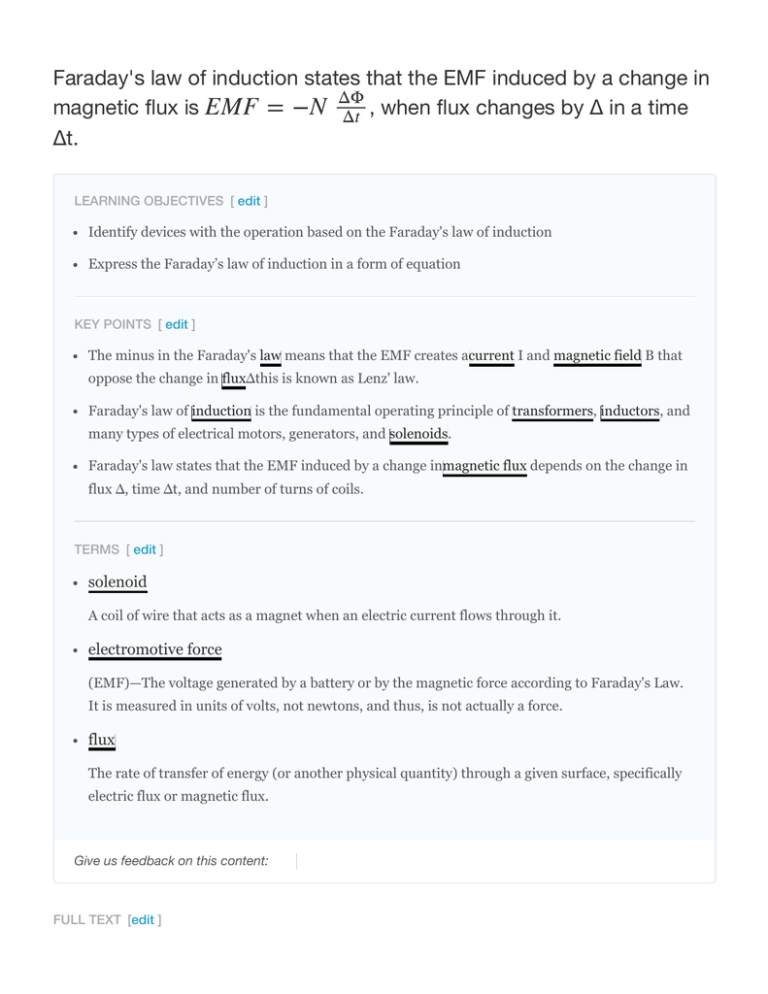
Faraday's law of induction states that the EMF induced by a change in magnetic flux is EMF = −N t , when flux changes by Δ in a time Δt. ΔΦ Δ LEARNING OBJECTIVES [ edit ] Identify devices with the operation based on the Faraday's law of induction Express the Faraday’s law of induction in a form of equation KEY POINTS [ edit ] The minus in the Faraday's law means that the EMF creates acurrent I and magnetic field B that oppose the change in fluxΔthis is known as Lenz' law. Faraday's law of induction is the fundamental operating principle of transformers, inductors, and many types of electrical motors, generators, and solenoids. Faraday's law states that the EMF induced by a change inmagnetic flux depends on the change in flux Δ, time Δt, and number of turns of coils. TERMS [ edit ] solenoid A coil of wire that acts as a magnet when an electric current flows through it. electromotive force (EMF)—The voltage generated by a battery or by the magnetic force according to Faraday's Law. It is measured in units of volts, not newtons, and thus, is not actually a force. flux The rate of transfer of energy (or another physical quantity) through a given surface, specifically electric flux or magnetic flux. Give us feedback on this content: FULL TEXT [edit ] Faraday's Law of Induction Faraday's law of induction is a basic law of electromagnetism that predicts how a magnetic field will interact with an electric circuit to produce an electromotiveforce (EMF). It is the fundamental operating principle of transformers, inductors, and many types of electrical motors, generators, and Register for FREE to stop seeing ads solenoids. Faraday's experiments showed that the EMF induced by a change in magnetic flux depends on only a few factors. First, EMF is directly proportional to the change in flux Δ. Second, EMF is greatest when the change in time Δt is smallest—that is, EMF is inversely proportional to Δt. Finally, if a coil has N turns, an EMF will be produced that is N times greater than for a single coil, so that EMF is directly proportional to N. Theequation for the EMF induced by a change in magnetic flux is EM F = −N ΔΦ t . Δ This relationship is known as Faraday's law of induction. The units for EMF are volts, as is usual. Lenz' Law The minus sign in Faraday's law of induction is very important. The minus means that the EMF creates a current I and magnetic field B that oppose the change in flux Δthis is known as Lenz' law. The direction (given by the minus sign) of the EMF is so important that it is called Lenz' law after the Russian Heinrich Lenz (1804–1865), who, like Faraday and Henry, independently investigated aspects of induction. Faraday was aware of the direction, but Lenz stated it, so he is credited for its discovery . Lenz' Law (a) When this bar magnet is thrust into the coil, the strength of the magnetic field increases in the coil. The current induced in the coil creates another field, in the opposite direction of the bar magnet's to oppose the increase. This is one aspect of Lenz's law—induction opposes any change in flux. (b) and (c) are two other situations. Verify for yourself that the direction of the induced Bcoil shown indeed opposes the change in flux and that the current direction shown is consistent with the right hand rule. Energy Conservation Lenz' law is a manifestation of the conservation of energy. The induced EMF produces a current that opposes the change in flux, because a change in flux means a change in energy. Energy can enter or leave, but not instantaneously. Lenz' law is a consequence. As the change begins, the law says induction opposes and, thus, slows the change. In fact, if the induced EMF were in the same direction as the change in flux, there would be a positive feedback that would give us free energy from no apparent source—conservation of energy would be violated.


